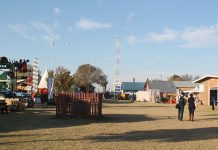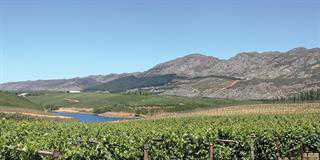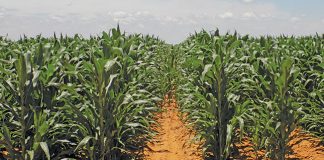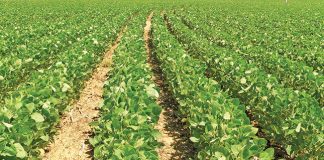Research conducted in Hopefield, Western Cape, aim to show that with an understanding of protea nutrition farmers could improve their protea yields while supporting biodiversity. Heidi Hawkins, a botanist involved in the trials, discusses some of their major findings.
Protea farming is attractive to farmers as it has a growing market and has great potential of being integrated into conservation areas. I t is now well accepted that conservation cannot be limited to reserves, and farms can play an important role in maintaining biodiversity. The impact proteas have on surrounding biodiversity can be relatively low, although hybridisation with native Proteaceae remains a danger.
Proteas can be ecofriendly as they are a low-input crop in terms of fertilisers, water and pesticide additions. Knowledge of protea nutrient requirements would not only mean better yields and potential money saving for farmers, but would allow the use of old farms instead of land with native vegetation. Proteas are often farmed in lowland fynbos, which is critically endangered by urban development and agriculture. The nutrition trials T he trials took place at Arnelia Farms, owned by Hans Hettasch who farms proteas near Hopefield in the Western Cape.
The area, being sandy and nutrient-poor, provided an almost hydroponic-like system, and was ideal for on-farm trials to see just how much is enough (or too much) to feed proteas. M ike Cramer, a botanist at the University of Cape Town (UCT), and Hans Hettasch initially met and discussed trials in 2000. Once the first trials had started Heidi Hawkins, also from UCT’s botany department, came on board. These trials are important for the protea farmer’s wallet and for establishing best practice guidelines for cultivating proteas. Because the Proteaceae family (proteas, leucadendrons and leucospermums or pincushions) is adapted to low-nutrient soils in the Cape Floristic Region, it is sometimes thought best to avoid adding nutrients at all, especially phosphorus (P).
Proteas are particularly adapted to acquiring soil P using a kind of acid extraction of the soil with organic acids exuded from their cluster roots. However, the reality is that harvesting of flowering stems for the cut-flower industry eventually depletes soil nutrient levels sufficiently to reduce yields, as shown by the researchers’ studies and by studies conducted in Australia. he first step in these trials was to establish how much nutrients to apply so that there is minimal accumulation or leaching of nutrients.
Accumulation would be a waste and pollute the soil, while leaching would pollute the groundwater. An obvious solution would be to apply slow- or controlled-release fertilisers. But the researchers wanted to begin with more controlled experiments where they would know exactly how much was applied and at what rate. hey set out to determine how much ended up in the plants, how much was left over in the soil and how much leached away. They also wanted to compare various nitrogen forms. Since many farmers use fertigation (nutrients in the irrigation water), and since this satisfied all these requirements, that is the route they chose. Like children in a sweetshop?
What first became evident from the nutrient trials was when presented with high amounts of nitrogen (N) and phosphorus (P), proteas did not limit their intake – as do most crop plants. Instead, they continue to take up nutrients, eventually to the detriment of plant growth and survival. Like children presented with sweets in a sweetshop, proteas don’t know when to stop. The reason for this is that proteas have never been exposed to high nutrients and therefore get confused when confronted with an abundance of P or N. In the Cape Floristic Region, soils are so low in both N and P that proteas have either lost or never evolved the mechanisms to stop taking up nutrients when enough is enough. Rather, they’ve evolved highly specialised roots that are very efficient at extracting P and N from even poorly soluble forms, like rock P or organic compounds.
Crop plants, like wheat, which have been exposed to high N and P levels over hundreds of years of breeding, have a mechanism called “feedback inhibition”. This means when enough of something has been taken up, the plant inhibits the uptake of more, thus preventing toxicity. Proteas, however, simply gorge on the “sweets” presented and will do so until toxicity and even death. Nutrients are not evil incarnate Despite the dangers of overfeeding proteas, the trials showed that protea growth increased significantly with small additions of nutrients. Note that the soils in this trial had about 35mg P/kg soil and 300mg N/kg soil. If soils contain more than this, it is best not to add nutrients.
However, it’s important to remember that as biomass is removed from the land, the soil nutrients will decrease over a period of five to 10 years. Through these trials the researchers aim eventually to produce guidelines on how much to fertilise depending on soil nutrient levels. In this trial, small additions of N (2g-6g urea/1 000 litres, 30 litres/plant/week) significantly improved growth of Leucadendron “Safari Sunset” and Leucospermum “Succession” growing on Strandveld sandy soil. Larger additions of N (up to 120g urea/1 000 litres) resulted in poor growth in both cultivars and N accumulation in the soil. Small additions of P (1,4g potassium phosphate/1 000 litres) dramatically improved growth of both cultivars and resulted in no accumulation or loss of P in the soil (see Figure 1). Larger additions of P (up to 70g potassium phosphate/1 000 litres) resulted in poor growth, P toxicity symptoms (leaf necrosis or blackening, chlorosis or leaf yellowing and “rosetting” of leaves – shortening of internodes and stunted growth) and P leaching from the upper soil layers. Best N forms in descending order of both plant visual appearance and vegetative yield were: urea > or = ammonium nitrate > ammonium sulphate > calcium nitrate.
Under conditions of maximum growth (1,4g potassium phosphate and 6g urea/1 000 litres), “Safari Sunset” and “Succession” removed all or most of the N, P and K (potassium) supplied over six months, without any accumulation in the soil. Converted to kg/ha, these fertigation rates are 29kg urea/ha and 7kg potassium phosphate/ha, with plants 1m apart on rows and 1,5m apart between rows. In subsequent trials with many cultivars, the team also found that small amounts of N and P were preferred, but within this there were some cultivar differences (see Table 1). Note that all treatments in Table 1, even the “High” ones, had very low nutrient concentrations.
Organic and slow-release – the way to go Interestingly, when proteas were growing best they took up more N and P than what was supplied by fertigation, that is, they took up extra nutrients from the soil. However, supplying higher amounts of soluble N and P adversely affected growth. Thus, a more insoluble, in other words a complex or slow-release, form of N and P other than urea and soluble phosphate is required to replace losses from the farm soil at the low concentrations required for proteas. Follow-up trials based on these fertigation trials are now under way. The researchers will be testing application rates of organic and slow-release fertilisers, and a slow-release form of phosphate (such as rock phosphate) on sandy and loamy soils. For more information contact Heidi Hawkins or Michael Cramer on (021) 650 2442/2444 or e-mail [email protected]; [email protected]. |FW
SOURCES
- Kaiser, 2000. South African Floriculture Cluster Study. Kaiser associates, .
- Little, RM; Crowe, TM 1998. Habitat fragmentation limits the distribution of Cape francolin Francolinus capensis, on deciduous fruit farms in South Africa. African Journal of Ecology 36, 140-147.
- Carter, C 2005. Meet the mutant proteas. The Independent 18.06.05
- Cowling, RM; Pressey, RL; Rouget, M; Lombard, AT 2003. A conservation plan for a global biodiversity hotspot – the Cape Floristic Region, South Africa. Biological Conservation 112, 191-216.
- Witkowski, ETF; Lamont, BB; Obbens, FJ 1994. Commercial picking of Banksia hookeriana in the wild reduces subsequent shoot, flower and seed production. J. Appl. Ecol. 31, 508-520.
- Wijnands, J 2005. Sustainable international networks in the flower industry. Bridging empirical findings and theoretical approaches. Scripta Horticulturae 2, 1-93.
Best practice guidelines – under construction
The total area of Proteaceae under cultivation in the world is more than 6 000ha, with over 3 000ha of this in SA. Low production and lack of compliance with ecolabelling standards are hindering SA’s competitiveness in the protea industry. Cultivation will always constitute a threat to native Proteaceae populations and biodiversity in general. It is therefore imperative that protea farmers try to employ best practice principles. Perhaps by doing this, the industry could even develop its own ecolabel and satisfy one of the factors limiting the industry’s potential abroad.
These principles would supplement the Biodiversity Management Recommendations of the SA Biodiversity Institute (seewww.bgis.sanbi.org.za), to: Promote connectivity of natural habitat within threatened • ecosystems (such as renosterveld) and between threatened ecosystems (for example, between renosterveld and fynbos). Clear alien vegetation and rehabilitate habitats in threatened ecosystems and in areas important for maintaining ecological processes. Ensure that ecological processes such as periodic fires or pollination are maintained in consultation with CapeNature (www.capenature.org.za).
Adopt nature-friendly farming practices, such as biological pest control, maintaining strips of indigenous vegetation between fields, and reducing the use of fertilisers and pesticides near indigenous vegetation or wetlands. Promote sustainable land uses that are compatible with maintaining ecosystem functioning.
These guidelines will be supplemented by specifics for the best practice of protea cultivation, such as how to use old farm lands, soil and leaf ameliorative agents that can be used to remove excess P (when above about 40mg P/kg soil) from these lands, irrigation guidelines, and ranges and types (for example, slow-release) of nutrient additions that are judicious and will avoid adverse effects (increased water use and decreased drought tolerance of sclerophyllous or hard-leaved plants, invasion by herbaceous annuals, reduced lifespan and unnecessary accumulation of nutrients in soil or leaching of nutrient into the groundwater). Meanwhile, a pamphlet on nutrient deficiencies in proteas has been compiled by the research group and is available to members of the Protea Producers of SA.













